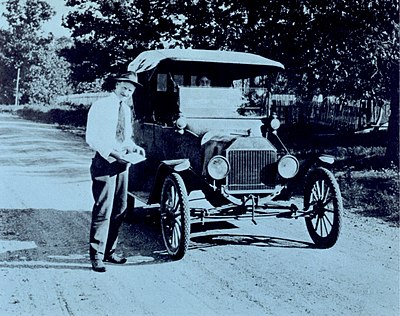
The Jefferson Highway after improvement as a gravel road.
Expansion of the Object Lesson Road Program
When Page became director of the Office of Public Roads (OPR) in 1905, only 14 States had highway departments, and 5 of these were less than 6 months old.[N 1] The mileage of roads under State control was very small, and State expenditures, mostly in the form of aid to the counties and townships, were only about 3 percent of total road expenditures in the United States.[N 2]
It was as evident to Director Page as it had been to his predecessors that the main effort for improving the rural roads would have to be directed to the counties and townships. Up to this time, the OPR’s most popular work with the local governments had been the object lesson roads, and already ample evidence of their effectiveness was beginning to accumulate. This evidence was summarized by Director Dodge in 1904:
. . . a section of good road built as an object lesson under the direction of the United States Government in any community has the effect of awakening much greater interest than such a road constructed by the local authorities. That the people desire instruction by the building of object lesson roads and are willing to bear the expense incident thereto is fully proved by the requests received for cooperation, the number being far more than we are able to comply with. That the results are almost uniformly satisfactory and frequently beyond the most sanguine expectation is demonstrated by reference to the letters embodied in this report from representative citizens in the sections where the roads were built and by personal investigations by representatives of this Office. In some instances the object lesson resulted in the slow but steady improvement of the common roads; in a few cases the results were the inauguration of extensive systems of road building. In practically every instance some measure of progress resulted from the object lesson. It would seem to be conservative to estimate that an average of at least 10 miles of improved highways are constructed as a result of the building of each of these roads. . . .[3]
- ↑ Massachusetts (organized 1893), New Jersey (1894), Connecticut (1895), Rhode Island (1896), New York (1898), Vermont (1898), Pennsylvania (1903), Ohio (1904), Iowa (1904), Illinois (1905), Michigan (1905), Minnesota (1905), New Hampshire (1905), Washington (1905).[1]
- ↑ In 1904 total road expenditure, including the estimated value of statute labor, was $79.77 million, of which $2.6 million was State aid.[2]
Page, whose budget had been increased to $50,000, decided to expand the object lesson road program and change its emphasis away from macadam construction to a wider use of local materials, particularly the most abundant of all—earth, clay and sand. As he wrote in 1909:
65
- ↑ AASHO—The First Fifty Years, 1914–1964 (American Association of State Highway Officials, Washington, D.C., 1965) pp. 322–330.
- ↑ M. Eldridge, Public-Road Mileage, Revenues and Expenditures in the United States in 1904, Bulletin No. 32 (Office of Public Roads, Washington, D.C., 1907) pp. 16–18.
- ↑ Bureau of Public Roads Annual Report, 1904, pp. 442, 443.
